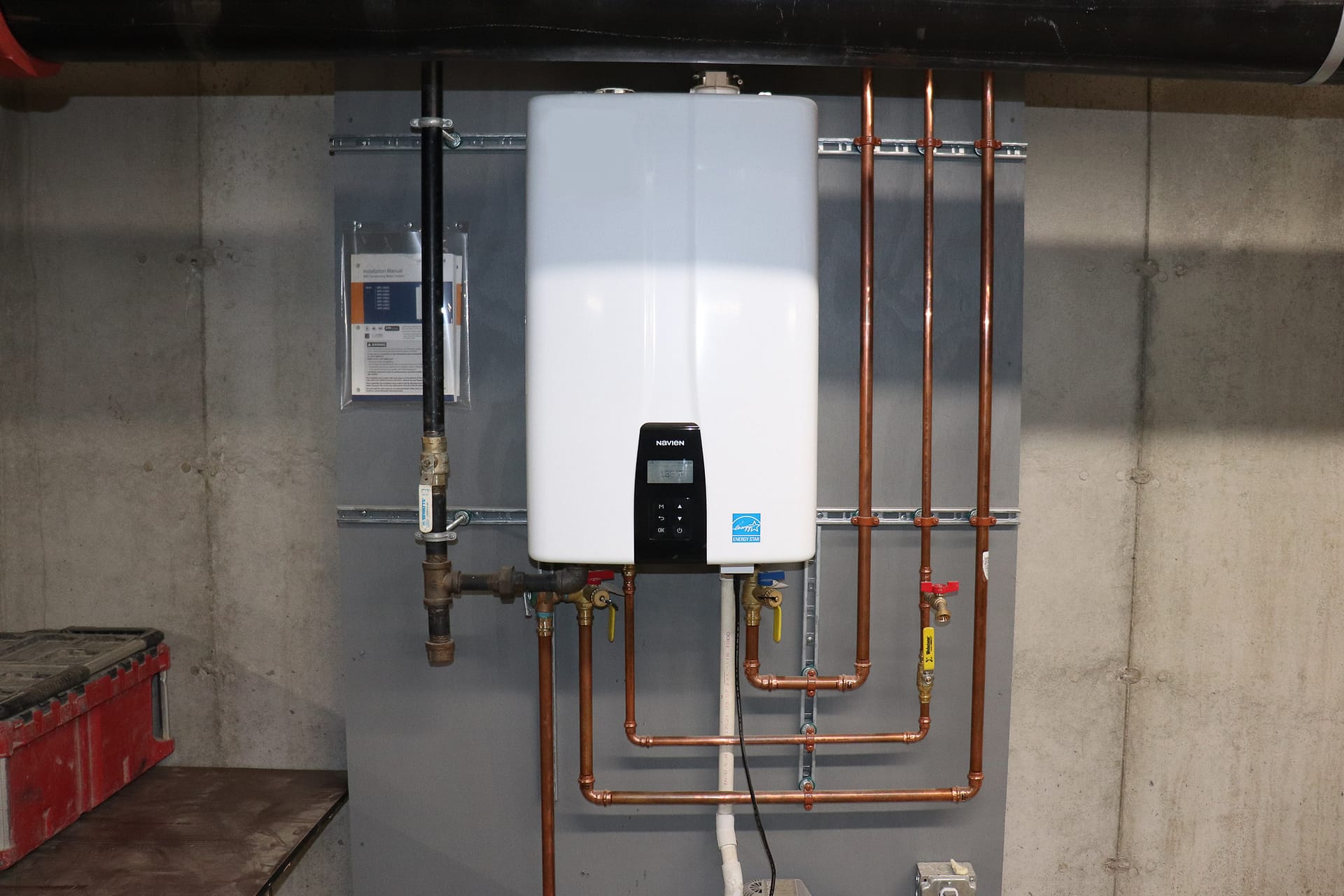The majority of American homes heat their water in a tanked system. It’s what we’re used to and they certainly have their advantages. That being said, progress waits for no man and technology marches ever onwards. Is it time to consider switching to a tankless water heater?
As many people may not be fully aware of all their options when it comes time to replace their current water heating system, let’s take a closer look at the benefits of a tankless water heater and how they compare to the styles we’re more familiar with.
What Is A Tankless Water Heater?
As the name may suggest, a tankless water heater is a system for heating water without storing it in a bulky tank. While much of Europe has been using them for decades, they’re only starting to catch up on traditional systems in the US.
Some systems may only heat the water that comes from your faucet or shower, others may be combined with your home’s heating system (a combi-boiler) but whichever you’re looking at, they basically work the same way: heating small quantities of water on demand.
In comparison, a traditional tanked system heats a whole tank full of water (often up to 50 or even 80 gallons) a go.
How Does A Tankless System Work?
The mechanics of a tankless hot water heater aren’t hugely different from their tanked counterparts at a high level. Water is heated by either a gas burner or an electric element. The real difference comes in the scale at which this is done.
In a tanked system, the whole tank is heated at the same time by direct application of a heat source, but in a tankless one, only about 2-5 gallons is heated at any one moment as it flows through a heat exchanger.
This speeds the process up considerably and allows the refresh rate to be basically instantaneous.
Benefits of A Tankless Water Heater
If you’re considering switching to a tankless water heater, you’re in good company. Many households are weighing the pros and cons and opting to replace traditional tanked systems with newer models.
Here are a few of the advantages of tankless water heaters compared to conventional systems:
Energy Efficiency
In a time of environmental crisis and constantly spiralling utility costs, people are placing more emphasis on introducing more efficient systems into their homes. A tankless water heater offers a great way to save energy.
While a traditional tanked heater has to heat the whole tank, even if you only need a little hot water, the same can’t be said for tankless systems which heat on demand. Thanks to the fact that they are only ever heating the water as it’s being used, they can offer great savings.
Longevity
While tanked systems are relatively easy to maintain and to replace the individual components as they start to wear out, tankless systems may last longer overall.
With regular maintenance a tankless system could last between 15-20 years. When you compare this to the 8-12 years that you’ll get out of a traditional system, you can see the advantages.
Space Saving
American homes have traditionally been a bit larger than those of our European cousins, so space saving hasn’t been much of a consideration in previous generations. As this trend is beginning to reverse (the average home is nearly 200sq feet smaller than it was a decade ago) and working from home makes us value space more, it’s worth thinking about.
Even a relatively small tanked system is bulky, taking up valuable real estate in your basement or attic- space which could be storage, a bedroom or home cinema. That’s not so with a tankless system which can be tucked neatly away on the wall in a cupboard.
Continuous Hot Water Supply
Anyone who’s ever had to endure being the last one in the family to take a shower will appreciate this benefit of tankless water heaters.
As they work by heating water on demand, that is as it’s pulled through the system by an open faucet, tankless systems don’t require time to recover between uses like their traditional counterparts do. This makes them ideal for larger families.
Lower Operational Costs
As a general rule of thumb, on demand water heaters are more efficient than ones which rely on storage. How much more efficient will depend on your model and household usage, but it can be up to 34% if you’re a fairly low-usage household.
As you require more hot water, these savings shrink, but they’re never insignificant. If you use more like 80+ gallons a day, savings of 14% are possible. Over the course of a year, this represents a significant chunk of your utilities bills.
Considerations Before Making The Switch
Of course, nothing is perfect and there are some downsides to go along with the advantages of tankless water heater systems that should be properly considered before switching.
Upfront Costs
There’s no disguising it, tankless heaters do cost more upfront than their traditional counterparts. Not only do the units themselves cost more, installing one where a conventional one was in place before will require retrofitting your home, significantly bumping up the initial outlay.
Home Size and Capacity Requirements
How effective a tankless system is will depend on how large a home you have and how heavy your water usage is. Larger households may get more value out of a large tanked system, even factoring in higher utilities and recovery times.
Retrofitting Requirements
A large part of why tankless systems have been relatively slow to take off in the US is that, when you’ve had a traditional system in place, they require a reasonable amount of disruptive (and potentially expensive) retrofitting work.
Choosing the Right Tankless Water Heater
With a baffling range of models, making sure you get the right one for your home’s needs can be a bit of a mine field. Things to consider include:
- Fuel: Gas, electricity and tanked propane are all options to consider, depending largely on location.\
- Size: depending on your mains flow rate and the difference between your desired rise in temperature and it’s starting point, different sized units will be required to meet your needs.
- Brand and Model Reviews: With such a baffling range on the market, it’s worth reading up as widely as possible to ensure you can balance upfront and long-term costs with reliability.
Whatever your thoughts on these points, it’s best to consult a professional before moving forward.
Professional Installation
Retrofitting or installing a tankless water heater is a task for an experienced professional. Gas and electricity are both incredibly dangerous and the savings are in no way worth the risk.
During the installation process, your plumber will:
- Cut the power
- Turn off the water
- Drain the current system (if present)
- Fit the new system, including replacing any necessary pipe work
- Fit pressure control valves
- Reconnect everything
While planning the job, your plumber will consider:
- Location: tankless systems are most effective if placed close to the outlets they will supply
- Connections: regardless of fuel type, your heater will need to be connected to the electricity, may require access for gas and, obviously, will need space for both input and output pipes too.
- Ventilation: Tankless heaters require proper ventilation, especially gas fired models. The exact requirements vary from model to model, but your fitter will be able to ensure they’re met.
On-going Maintenance
As with any significant investment in your home, switching to a tankless water heater will require a certain level of upkeep to keep things running at peak efficiency.
Scheduling a regular inspection from a qualified professional will alert you to any issues before they become urgent and prolong the lifespan of your system. This is particularly important with gas based systems and, in fact, may be a legal requirement from your local authorities.
Regular descaling, especially in ‘hard’ water areas will also boost both the efficiency and longevity of your tankless water heater. You can ask your plumber to do it for you (and this is certainly less hassle) but if you’re the type to DIY what you can, try the following:
- Turn off the gas
- Turn off both hot and cold isolation valves
- Turn the drain valves on, each in turn (catching it in a bucket)
- Connect a hose to a small submersible pump and place it in to a bucket of vinegar
- Connect up the pump’s output to the first drain valve
- Place the output hose in the bucket too
- Turn on the pump and let the vinegar circulate for about half an hour
- Once done, flush the system with cold water for 5 minutes
- Close the drain valves and turn on the water again then restart the system
So, is it worth switching to a tankless water heater? There are certainly a lot of advantages but ultimately, the right decision will vary from home to home.

